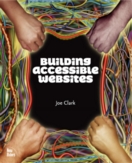![[joeclark.org: Web AccessiBlog] joeclark.org: Web AccessiBlog](accessiblog5.gif)
No longer updated
AccessiBlog topics
Building Accessible Websites
now available
 |
The AccessiBlog is one of five Joe Clark Weblogs (Axxlog, Bookblog, fawny.blog, NUblog).
You are here: joeclark.org
> Captioning and media access
>
Web AccessiBlog > Lawsuits
Updated 2002.10.12
Lawsuits
Lawsuits are absolutely the worst reason to code accessibly, but sometimes that’s what it takes.
- One inconclusive case: Hooks v. OKBridge, Inc. (2002.10.12)
- Suit Over Airlines’ Web Sites Tests Bounds of ADA: “When Robert Gumson logs on to the Internet, he uses a software program that converts Web site content into speech. But when he logged on to Southwest Airlines’ Web site to make a reservation, Gumson, who is blind, found that the site was incompatible with his screen-reader program. So Gumson and a Miami Beach, Fla.-based disability rights group, Access Now, filed lawsuits in U.S. District Court in Miami in June and July against Dallas-based Southwest and Dallas-based American Airlines under the Americans with Disabilities Act. They are doing so under an untested legal theory. Namely, that ADA provisions on the accessibility of public accommodations to the disabled apply to Internet Web sites just as they do to brick-and-mortar facilities like movie theaters and department stores” (2002.10.12)
- Web accessibility (Harry Woodrow): “This paper presents a broad overview of the effect of disabilities on an individual’s ability to access a Web page, the social and legal factors affecting creators of Web pages and reasons why Web authors should consider universal accessibility factors. Consideration is given to ways individuals with specific access problems may access information and particular emphasis is given to the Accessibility Options used in Microsoft operating systems such as Windows 2000 and browsers such as Microsoft Internet Explorer 5.5. An overview of the World Wide Web Consortium access standards for people with disabilities is given together with some examples of how to assist in providing universal access. In conclusion, an example of a recent court case regarding a major Web site is given to emphasise the importance of accessibility and the cost of not taking this into account” (2002.02.17)
- It’s time to let the blind surf: “The US Supreme Court has just held that a ban on Martin’s use of a golf cart during tournaments violates the Americans with Disabilities Act. For all my sympathy for Martin, I consider the ruling deplorable. Will we soon see the Supremes donning striped jerseys to adjudicate 24-second violations? Still, the Martin case may finally capture the attention of some people who should comply with the ADA. I speak of Web site designers, a persistently clueless bunch who’ve shamefully neglected their duty to millions of disabled Americans” (2001.06.03)
- Making sites accessible to the whole wide world: “But despite the widespread use of the Internet, there are no legal parameters that clearly define what makes a Web site ADA-compliant. It should only be a matter of time, however, before Web sites come under legal challenge for not providing universal accessibility. Until then, lawyers and law firms – because of their unique understanding of the ADA and its implications – can and should take a leadership role in creating accessible sites. To do this, firms and their Webmasters need to first understand some of the unique challenges that the disabled face when going online” (2001.06.03)
- FleetBoston’s accessibility
guidelines (part of a settlement also pertaining to bank
machines): Full of little mistakes and the same glib, overarching,
impossible-to-implement, excessively terse instructions.
“Provide text equivalents for images, animations, applets,
scripts, buttons, hyperlinks, and audio”: How do you provide
a text description for a hyperlink? Unless it is also an image
(elsewhere covered), it’s already text. “Do not convey
information with color alone.... To highlight or flag a piece of
information with RED to indicate a negative point, as opposed to a
GREEN highlight or flag to indicate a good point”: OK.
What’s the alternative? “Provide an auditory
description of the important information of a multimedia
presentation”: How? This makes it sound as easy as making a
paragraph bold and italic. “All graphics containing text or
other information content must have a descriptive
ALTtag orLONGDESC”: All graphics must have anALT; you can’t skip it in favour ofLONGDESC, which is poorly supported. And so on, and so on (2001.03.07) - Olympics
- Reader’s guide to Sydney Olympics accessibility complaint (2001.01.11)
- Olympics Site Discriminates Against the Blind: “While the Royal Blind Society welcomed the outcome of a Web site accessibility battle between a blind Sydney man and the Sydney Organising Committee for the Olympic Games (SOCOG) and its implications for the visually-impaired around the world, SOCOG said it would ignore the order as its partner IBM says it would be too costly and time-consuming to make the Web site accessible” (2002.10.12)
- Olympic Failure: A Case for Making the Web Accessible by Tom Worthington, one of the expert witnesses called in Maguire vs. SOCOG (2001.05.18)
- AOL: In National Federation of the Blind vs. AOL, AOL agreed to make certain accessibility modifications; NFB may resume the lawsuit in a year’s time under certain conditions. AOL denies, rather desperately, that that the Americans with Disabilities Act applies to the Web